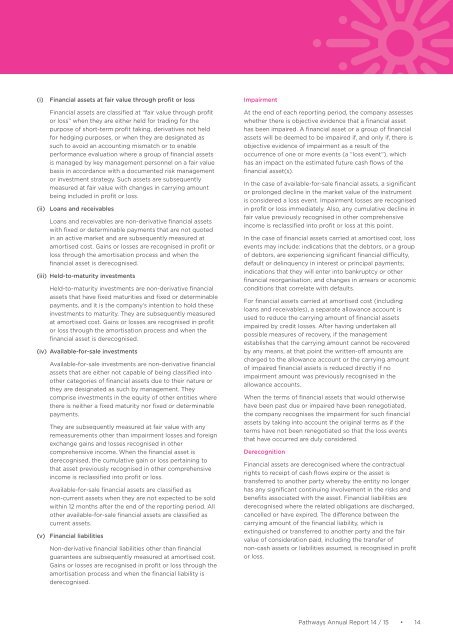2015 Pathways Annual report
2015 Pathways Annual report
2015 Pathways Annual report
Create successful ePaper yourself
Turn your PDF publications into a flip-book with our unique Google optimized e-Paper software.
(i)<br />
Financial assets at fair value through profit or loss<br />
Impairment<br />
Financial assets are classified at “fair value through profit<br />
or loss” when they are either held for trading for the<br />
purpose of short-term profit taking, derivatives not held<br />
for hedging purposes, or when they are designated as<br />
such to avoid an accounting mismatch or to enable<br />
performance evaluation where a group of financial assets<br />
is managed by key management personnel on a fair value<br />
basis in accordance with a documented risk management<br />
or investment strategy. Such assets are subsequently<br />
measured at fair value with changes in carrying amount<br />
being included in profit or loss.<br />
(ii) Loans and receivables<br />
Loans and receivables are non-derivative financial assets<br />
with fixed or determinable payments that are not quoted<br />
in an active market and are subsequently measured at<br />
amortised cost. Gains or losses are recognised in profit or<br />
loss through the amortisation process and when the<br />
financial asset is derecognised.<br />
(iii) Held-to-maturity investments<br />
Held-to-maturity investments are non-derivative financial<br />
assets that have fixed maturities and fixed or determinable<br />
payments, and it is the company’s intention to hold these<br />
investments to maturity. They are subsequently measured<br />
at amortised cost. Gains or losses are recognised in profit<br />
or loss through the amortisation process and when the<br />
financial asset is derecognised.<br />
(iv) Available-for-sale investments<br />
Available-for-sale investments are non-derivative financial<br />
assets that are either not capable of being classified into<br />
other categories of financial assets due to their nature or<br />
they are designated as such by management. They<br />
comprise investments in the equity of other entities where<br />
there is neither a fixed maturity nor fixed or determinable<br />
payments.<br />
They are subsequently measured at fair value with any<br />
remeasurements other than impairment losses and foreign<br />
exchange gains and losses recognised in other<br />
comprehensive income. When the financial asset is<br />
derecognised, the cumulative gain or loss pertaining to<br />
that asset previously recognised in other comprehensive<br />
income is reclassified into profit or loss.<br />
Available-for-sale financial assets are classified as<br />
non-current assets when they are not expected to be sold<br />
within 12 months after the end of the <strong>report</strong>ing period. All<br />
other available-for-sale financial assets are classified as<br />
current assets.<br />
(v) Financial liabilities<br />
Non-derivative financial liabilities other than financial<br />
guarantees are subsequently measured at amortised cost.<br />
Gains or losses are recognised in profit or loss through the<br />
amortisation process and when the financial liability is<br />
derecognised.<br />
At the end of each <strong>report</strong>ing period, the company assesses<br />
whether there is objective evidence that a financial asset<br />
has been impaired. A financial asset or a group of financial<br />
assets will be deemed to be impaired if, and only if, there is<br />
objective evidence of impairment as a result of the<br />
occurrence of one or more events (a “loss event”), which<br />
has an impact on the estimated future cash flows of the<br />
financial asset(s).<br />
In the case of available-for-sale financial assets, a significant<br />
or prolonged decline in the market value of the instrument<br />
is considered a loss event. Impairment losses are recognised<br />
in profit or loss immediately. Also, any cumulative decline in<br />
fair value previously recognised in other comprehensive<br />
income is reclassified into profit or loss at this point.<br />
In the case of financial assets carried at amortised cost, loss<br />
events may include: indications that the debtors, or a group<br />
of debtors, are experiencing significant financial difficulty,<br />
default or delinquency in interest or principal payments;<br />
indications that they will enter into bankruptcy or other<br />
financial reorganisation; and changes in arrears or economic<br />
conditions that correlate with defaults.<br />
For financial assets carried at amortised cost (including<br />
loans and receivables), a separate allowance account is<br />
used to reduce the carrying amount of financial assets<br />
impaired by credit losses. After having undertaken all<br />
possible measures of recovery, if the management<br />
establishes that the carrying amount cannot be recovered<br />
by any means, at that point the written-off amounts are<br />
charged to the allowance account or the carrying amount<br />
of impaired financial assets is reduced directly if no<br />
impairment amount was previously recognised in the<br />
allowance accounts.<br />
When the terms of financial assets that would otherwise<br />
have been past due or impaired have been renegotiated,<br />
the company recognises the impairment for such financial<br />
assets by taking into account the original terms as if the<br />
terms have not been renegotiated so that the loss events<br />
that have occurred are duly considered.<br />
Derecognition<br />
Financial assets are derecognised where the contractual<br />
rights to receipt of cash flows expire or the asset is<br />
transferred to another party whereby the entity no longer<br />
has any significant continuing involvement in the risks and<br />
benefits associated with the asset. Financial liabilities are<br />
derecognised where the related obligations are discharged,<br />
cancelled or have expired. The difference between the<br />
carrying amount of the financial liability, which is<br />
extinguished or transferred to another party and the fair<br />
value of consideration paid, including the transfer of<br />
non-cash assets or liabilities assumed, is recognised in profit<br />
or loss.<br />
<strong>Pathways</strong> <strong>Annual</strong> Report 14 / 15 • 14


